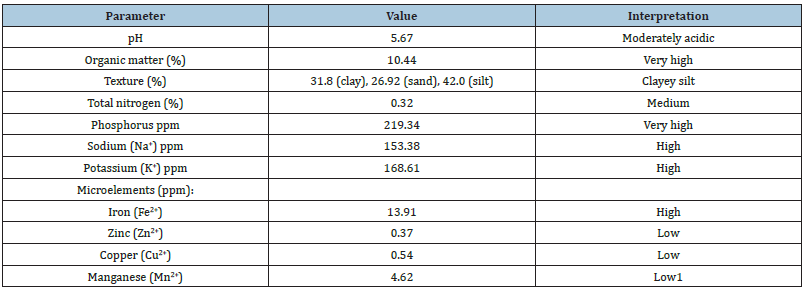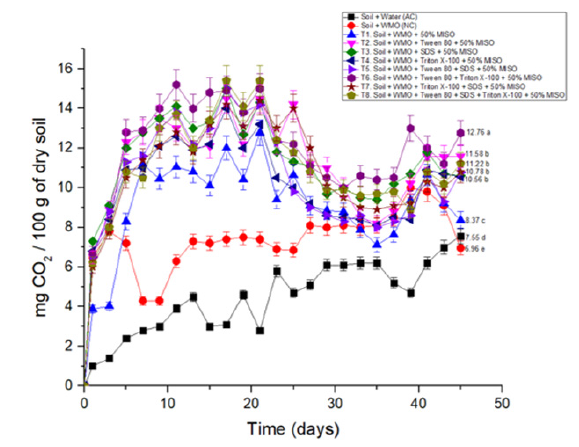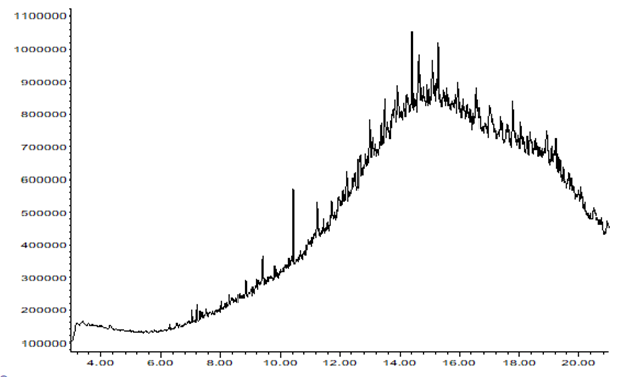- Submissions

Full Text
Modern Concepts & Developments in Agronomy
Biological Removal of Waste Motor Oil from an Agricultural Soil by Detergents and Mineral Solution
Blanca Celeste Saucedo-Martínez, Liliana Márquez-Benavides, Gustavo Santoyo-Pizano and Juan Manuel Sánchez Yáñez*
Environmental Microbiology, Chemical-Biological Research Institute, Ed-B3, Universidad Michoacana de San Nicolás de Hidalgo, Francisco J. Mujica S/N, Col Felicitas del Rio. Post code. 58000, Morelia, Mich, México.
*Corresponding author: Juan Manuel Sánchez Yáñez, Environmental Microbiology, Chemical-Biological Research Institute, Ed-B3, Universidad Michoacana de San Nicolás de Hidalgo, Francisco J. Mujica S/N, Col Felicitas del Rio. Post code. 58000, Morelia, Mich, México. Email: syanez@umich.mx
Submission: October 28, 2022;Published: November 30, 2022

ISSN 2637-7659Volume12 Issue 1
Abstract
Agricultural soil polluted by Waste Motor Oil (WMO) due to machinery used for plant production, causes loss of its productivity. WMO is chemical composed of an insoluble mixture of aliphatic, aromatic and polycyclic hydrocarbons. To solve this problem, it is necessary to start biostimulation with a mixture of detergents chemically compatible with WMO hydrocarbons, following by biostimulation applying mineral solution according to the physicochemical properties of the agricultural soil. Therefore, the aim of this work was to improve biostimulation of WMO polluted soil by emulsification with Tween 80®, Triton X-100® and sodium dodecyl sulfate, followed by a mineral solution. In that sense, the agricultural soil polluted by 60,000ppm of WMO in Bartha flasks was first biostimulated applied Tween 80®, Triton X-100® and sodium dodecyl sulfate, and then with a mineral solution. The response variables were carbon dioxide (CO2) production and final WMO concentration. Gas chromatography was used to determine the hydrocarbon type of the WMO before and after biostimulation of soil polluted by WMO. The experimental data were validated by Tukey HSD ANOVA. The results showed that the agricultural soil impacted by WMO biostimulated applied Tween 80®, Triton X-100® and mineral solution, after 45 days, registered 12.76mg of CO2/100g of dry soil corresponding a WMO decreasing from 60,000 to 11,000ppm, numerical values statistically different compared to the soil impacted by WMO not biostimulated with detergents and no biostimulated with mineral solution, used as negative control registered 6.96mg of CO2/100g of dry soil, corresponding to WMO decreased from 60,000 to 56,000ppm. The chromatogram of soil impacted by 60, 000ppm WMO after biostimulation with Tween 80®, Triton X-100® and mineral solution showed the disappearance of short and long chain aliphatic hydrocarbons up to 35 carbons, as well as low and high molecular weight aromatics up to 26 carbons. These results support that in agricultural soil contaminated by WMO biostimulation has to start with a detergent mixture for maximum emulsification that facilitates biostimulation with a mineral solution designed according to the chemical properties of the soil.
Keywords:Soil; Hydrocarbons; Amphoteric; Heterotrophic aerobic microorganisms; Mineralization
Experience Report
Waste Motor Oil (WMO) is one of the most common agricultural soil contaminants due to machinery used during plant cultivation. WMO are chemicals composed of an insoluble mixture of aliphatic, aromatic, and polycyclic hydrocarbons [1]. For WMO to be efficiently emulsified, it is necessary to initiate biostimulation with a mixture of detergents chemically compatible with WNO hydrocarbons. Subsequently the WMO can be mineralized by biostimulation of the soil with a mineral solution depending on the physicochemical properties of the soil related to the Carbon: Nitrogen (C: N) ratio as well as other essential minerals used by heterotrophic aerobic microorganisms native to this soil [2]. In the literature review report, between 80-90% of the related investigations use a single type of detergent, such as Tween 80®, whose composition is insufficient to emulsify most of the variety of hydrocarbons [3-5]. Therefore, the aim of this work was to improve biostimulation of soil polluted by WMO with Tween 80®, Triton X-100® and sodium dodecyl sulfate, followed a mineral solution.
Materials and Methods
Soil sample collection and preparation
Soil sampling was carried out based in NOM-021- SEMARNAT-2000 (NOM-021) [6] using the zigzag method at a depth of 20cm, from an agricultural area in the municipality of Morelia, Michoacán, Mexico, called “Uruapilla”. To avoid pests and diseases, the soil was solarized for 48 hours and sieved with a No. 10 mesh. Then, a physicochemical analysis of the soil was carried out according to NOM-021 before polluting agricultural soil by WMO.
Biostimulation experiment of soil polluted by 60,000 ppm WMO with Tween 80®, Triton X-100®, SDS® and with 50% mineral solution
To demonstrate that detergent mixing is necessary for WMO emulsification in soil biostimulation, a triplicate randomized block experiment was conducted in Bartha flasks with 100g of soil. Then the soil was contaminated by 60, 000 ppm WMO from an automobile mechanical workshop in the city of Morelia, Mich, Mexico. The volume of the WMO was measured with a glass pipette and poured into the soil to contaminate it. To start the soil was biostimulated with Tween 80®, Triton X-100®, SDS® and 50% mineral solution. The mineral solution had the following composition (g/L): NH4NO3 10, K2HPO4 2.5, K2HPO4 2, MgSO4 1, NaCl 0.1, CaCl2 0.1, FeSO4 traces, trace elements solution 10 and pH 6.5-6.8 according to the physicochemical agricultural soil proprieties based in organic matter, total nitrogen and phosphates concentration. In Bartha flasks with the contaminated soil, 9ml of 0.1N NaOH was introduced into the flask reservoir. The flasks were kept in incubation at 30 °C for 45 days. The indirect response variable of WMO metabolism was the released carbon dioxide (CO2) derived from biological activity and trapped by NaOH [7]. The mineralization of the WMO in the agricultural soil was complemented with the determination of the concentration of its hydrocarbons that disappeared by Soxhlet technique [8]. Experimental design is shown in Table 1.
Table 1:Experimental design of biostimulation of soil impacted by 60,000ppm WMO applied detergents and mineral solution.

Added= (+) no added= (-)
Identification of WMO hydrocarbons before and after biostimulation of contaminated soil
Soil samples impacted by WMO before and after biostimulation with detergents and mineral solution were analyzed in an Agilent Technologies 7890A series gas chromatograph coupled to 5975C series masses, 1.0μL of sample was injected in Spitless mode, helium (99.995% purity) was used as carrier gas in a Zebron capillary column. 5 MS 30.0m long, with an internal diameter of 0.25mm and a film thickness of 0.25mm. The injector temperature was 250 °C and the initial oven temperature was 50 °C with a ramp of 30-150 °C, ramp 2 of 10 °C c/min up to 310 °C/2min. The temperature detector was 280 °C with an equilibration time of 3 min and a maximum temperature of 320 °C (modified method of Peng et al. [9]).
Statistical Analysis
Differences in experimental data between groups were confirmed by one-way Analysis of Variance (ANOVA) and the Tukey HSD test (α = 0.05) with the Statgraphics Centurion XVI.II program [10].
Results and Discussion
The physicochemical analysis of the soil proprieties is shown in Table 2, where total nitrogen (N) had a mean value of 0.32 % and phosphates (PO4 -3) with a high value of 219.34ppm, (NOM-021- SEMARNAT-2000), these properties indicated that the soil required to be biostimulated with mineral solution at 50 %, to induce native heterotrophic aerobic microorganisms to eliminate WMO [11]. According to Figure 1, in agricultural soil polluted by WMO before biostimulation by detergents and mineral solution it shows that it was a heterogeneous mixture of linear and branched aliphatic HCs from 12 to 35 carbons; were also detected aromatics such as benzene, phenols and naphthalene.
Table 2:Physicochemical properties of soil not polluted by waste motor oil.

Figure 1:Chromatogram of soil impacted by 60, 000 ppm of waste motor oil before bio stimulation applied detergents and mineral solution at 50%.

Figure 2 shows biostimulation of agricultural soil polluted by WMO applied Tween 80, Triton X-100 and 50% mineral solution, by the amount of CO2 from WMO mineralization. While the same soil not polluted by WMO irrigated only with water or absolute control registered 7.55mg CO2/100g dry soil on day 45, derived from the mineralization of native organic matter due to aerobic heterotrophic microorganisms in any agricultural soil that, according to the physicochemical analysis, was high before the biostimulation by detergents and mineral solution. The value of CO2 released by the mineralization of organic matter in the uncontaminated agricultural soil used as an absolute control was subtracted from the value of CO2 in the soil polluted by WMO biostimulated by detergents and mineral solution to obtain only the CO2 released by WMO mineralization.
Figure 2:CO2 production during biostimulation of soil impacted by 60,000 ppm of waste motor oil applied Tween 80®, Triton X-100®, SDS® and biostimulation with mineral solution at 50%. (WMO: waste motor oil, AC: absolute control, NC: negative control, MISO: mineral solution. Different letters indicate statistical difference).

Biostimulation soil impacted by WMO applied Tween 80®, Triton X-100® and mineral solution at 50% released 12. 76mg CO2/100g dry soil, numerical value statistically different compared to soil polluted by WMO not biostimulated with detergents, neither mineral solution used as negative control registered 6.96mg CO2/100g dry soil, derived from natural attenuation; compared to soil polluted by WMO biostimulated only SDS® and mineral solution at 50% that generated 11.22mg CO2/100g dry soil.
The results support that biostimulation of agricultural soil polluted by WMO the chemical composition of Tween 80® [12] and Triton X-100® [13], were chemically compatible to emulsify WMO and improve soil biostimulation with 50% mineral solution to induced heterotrophic aerobic native microorganisms to mineralize most of the WMO as a carbon and energy source for maximum CO2 released. At the beginning of biostimulation of soil polluted by WMO its lightest fraction of hydrocarbons was rapidly oxidized [14].
Table 3 shows during biostimulation of soil polluted by WMO applied Tween 80® / Triton X-100® and mineral solution at 50%, reached 81.6 % mineralization corresponding to maximum oxidation of WMO from 60, 000ppm to 11, 000ppm. Biostimulation of soil contaminated by WMO with detergents and mineral solution according to the chromatogram in Figure 3 shows that short, long and linear aliphatic hydrocarbons, as well as some low and high molecular weight aromatics from WMO that were compatible with Tween 80® and Triton X-100® that achieved its maximum emulsification, to improve biostimulation applied mineral solution at 50 % to enhance the ability of native heterotrophic aerobic microorganisms to mineralize WMO.
Table 3:Concentration of waste motor oil in impacted soil biostimulated applied Tween 80®, Triton X-100®, SDS® and biostimulation with mineral solution at 50%.

*Different letters indicate statistical difference according to ANOVA-Tukey (p<0.05)
Figure 3:Chromatogram of soil impacted by 60, 000ppm waste motor oil after biostimulation applied Tween 80®, Triton X-100® and mineral solution at 50%.

The results of the soil impacted by WMO biostimulated applied Tween 80® / SDS® and then biostimulation with mineral solution at 50 %, indicating due to its chemical composition [15- 16], emulsified short chain linear hydrocarbons of WMO and the biostimulation applied mineral solution at 50% induced heterotrophic aerobic microorganisms to mineralize and decrease WMO from 60,000 to 15,400ppm equivalente at 74.3% of WMO. In agricultural soil impacted by WMO biostimulated applied Tween 80® / Triton X-100® / SDS® partially emulsified its hydrocarbons then biostimulation with mineral solution at 50% to improve the effective mineralization of WMO from 60,000 to 15,500 ppm equivalent to a 74.1% reduction in its concentration. The WMO reduction values, were statistically different compared to soil impacted by WMO biostimulated only with SDS®, that has linear carbon structure Ali et al. [17] to emulsify some hydrocarbons of WMO, then biostimulation by mineral solution at 50% registered decreased from 60,000 to 18,000ppm corresponding 70% elimination of WMO. In soil impacted by WMO biostimulated only with Triton X-100® having a short carbon chain and aromatic ring, partially emulsified short chain aliphatic hydrocarbons and some low molecular weight aromatics. Followed by biostimulation of heterotrophic aerobic microorganisms applied mineral solution at 50%, that effectively used them as only carbon source and energy decrease to reduce the WMO concentration from 60,000 to 19,500ppm or 65.7 or reduction [18].
Figure 3 shows the chromatogram of soil impacted by 60, 000ppm WMO after biostimulation with Tween 80®, Triton X-100® and mineral solution at 50%, shown the disappearance of short and long chain aliphatic hydrocarbons up to 35 carbons, as well as low and high molecular weight aromatics up to 26 carbons. These facts support the results of Table 3, that demonstrated the chemical compatibility of the detergents in soil biostimulation to emulsify WMO hydrocarbons, that biostimulated by mineral solution induced a rapid mineralization of WMO by the native aerobic heterotrophic microorganisms of agricultural soil to use those WMO hydrocarbons as the only source of carbon and energy [19].
Conclusion
This research showed that in any agricultural soil polluted by a mixture of hydrocarbons of the WMO type, biostimulation has to start with detergents according to the chemical properties of these hydrocarbons to ensure that the biostimulation with mineral solution is adequate to the chemical properties of the soil for efficient and fast mineralization of WMO in order to recover its health for reuse in the production of safe food.
Acknowledgement
To CONACYT For the scholarship to the first author, to project 2.7 2022) Coordination of Scientific Research, Universidad Michoacana de San Nicolás de hidalgo, the Rockefeller Foundation, Harvard University Cambridge, Ma, USA, Phytonutrimentos of Mexico, and BIONUTRA, Maravatío, Michoacan, México.
References
- Hu G, Li J, Zeng G (2013) Recent development in the treatment of oily sludge from petroleum industry: a review. Journal Hazardous Materials 261: 470-490.
- Englert CJ, Kenzie EJ, Dragun J (2019) Bioremediation of petroleum products in soil. In Principles and practices for petroleum contaminated soils, Routledge Publishers, England, UK, pp. 111-130.
- Effendi AJ, Kamath R, McMillen S, Sihota N, Zuo E, et al. (2017) Strategies for enhancing bioremediation for hydrocarbon-impacted soils. In SPE Asia Pacific Health, Safety, Security, Environment and Social Responsibility Conference. One Petro.
- Ramadan BS, Sari GL, Rosmalina RT, Effendi AJ (2018) An overview of electrokinetic soil flushing and its effect on bioremediation of hydrocarbon contaminated soil. Journal of Environmental Management 218: 309-321.
- Perini BLB, Bitencourt RL, Daronch NA, dos Santos Schneider AL, de Oliveira D (2020) Surfactant-enhanced in-situ enzymatic oxidation: A bioremediation strategy for oxidation of polycyclic aromatic hydrocarbons in contaminated soils and aquifers. Journal of Environmental Chemical Engineering 8(4): 104013.
- (2013) Norma oficial mexicana NOM-021-SEMARNAT-2000, que establece las especificaciones de fertilidad, salinidad y clasificación de suelos, estudio, muestreo y aná DOF secretaria de Gobernación, México.
- Kaboré-Ouédraogo PW, Ouattara CA, Savadogo PW, Ouattara AS, Traoré AS (2018) Impact of pollution by the hydrocarbons on the biological activity of soils in Ouagadougou, Burkina Faso. Journal of Soil Science and Environmental Management 9(11): 180-188.
- Morales-Guzmán G, Ferrera-Cerrato R, del Carmen Rivera-Cruz M, Torres-Bustillos LG, Arteaga-Garibay RI, et al. (2017) Diesel degradation by emulsifying bacteria isolated from soils polluted with weathered petroleum hydrocarbons. Applied Soil Ecology 121: 127-134.
- Peng S, Zhou Q, Cai Z, Zhang Z (2009) Phytoremediation of petroleum contaminated soils by Mirabilis Jalapa in a greenhouse plot experiment. Journal of hazardous materials 168(2-3): 1490-1496.
- Walpole RE, Myers RH, Myers SL, Ye K (2007) Probabilidad y estadística para ingeniería y ciencias, Pearson Educación, Mexico, (No. TA340. P76 2007).
- Al-Hawash AB, Dragh MA, Li S, Alhujaily A, Abbood HA, et al. (2018) Principles of microbial degradation of petroleum hydrocarbons in the environment. The Egyptian Journal of Aquatic Research 44(2): 71-76.
- Cheng M, Zeng G, Huang D, Yang C, Lai C, et al. (2018) Tween 80 surfactant-enhanced bioremediation: toward a solution to the soil contamination by hydrophobic organic compounds. Critical reviews in biotechnology 38(1): 17-30.
- Cecotti M, Coppotelli BM, Mora VC, Viera M, Morelli IS (2018) Efficiency of surfactant-enhanced bioremediation of aged polycyclic aromatic hydrocarbons-contaminated soil: Link with bioavailability and the dynamics of the bacterial community. Science of the Total Environment 634: 224-234.
- Dutta S, Singh P (2017) Efficiency of consortium for in-situ bioremediation and CO2 evolution method of refines petroleum oil in microcosms study. European Journal of Biological Research 7(2): 97-107.
- Tang X, Huston KJ, Larson RG (2014) Molecular dynamics simulations of structure–property relationships of Tween 80 surfactants in water and at interfaces. The Journal of Physical Chemistry B 118(45): 12907-12918.
- Tung CH, Huang GR, Chang SY, Han Y, Chen WR, et al. (2020) Revealing the Influence of Salts on the Hydration Structure of Ionic SDS Micelles by Contrast-Variation Small-Angle Neutron Scattering. The Journal of Physical Chemistry Letters 11(17): 7334-7341.
- Ali N, Bilal M, Khan A, Ali F, Iqbal HM (2020) Effective exploitation of anionic, nonionic, and nanoparticle-stabilized surfactant foams for petroleum hydrocarbon contaminated soil remediation. Science of the Total Environment 704: 135391.
- Lv H, Su X, Wang Y, Dai Z, Liu M (2018) Effectiveness and mechanism of natural attenuation at a petroleum-hydrocarbon contaminated site. Chemosphere 206: 293-301.
- Napp AP, Allebrandt SR, Pereira JES, Streit RSA, Bücker F, et al. (2022) Scale-up treatment of petroleum hydrocarbon-contaminated soil using a defined microbial consortium. International Journal of Environmental Science and Technology 19(7): 6023-6032.
© 2022 Juan Manuel Sánchez Yáñez. This is an open access article distributed under the terms of the Creative Commons Attribution License , which permits unrestricted use, distribution, and build upon your work non-commercially.
 a Creative Commons Attribution 4.0 International License. Based on a work at www.crimsonpublishers.com.
Best viewed in
a Creative Commons Attribution 4.0 International License. Based on a work at www.crimsonpublishers.com.
Best viewed in 







.jpg)






























 Editorial Board Registrations
Editorial Board Registrations Submit your Article
Submit your Article Refer a Friend
Refer a Friend Advertise With Us
Advertise With Us
.jpg)






.jpg)













.bmp)
.jpg)
.png)
.jpg)














.png)

.png)



.png)






